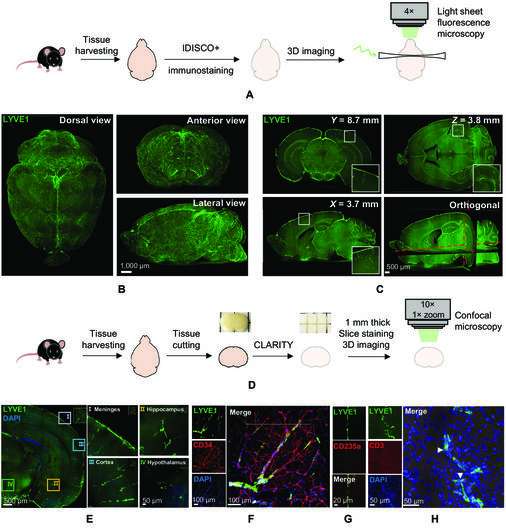This article has been reviewed according to Science X's editorial process and policies. Editors have highlighted the following attributes while ensuring the content's credibility:
fact-checked
proofread
Study demonstrates the existence of lymphatic vessels deep in mouse brain tissue

In a study that was recently published in Research, Dr. Nashat Abumaria's research team (Institutes of Brain Science, Fudan University) in collaboration with Dr. Yi Feng's team (Department of Integrative Medicine and Neurobiology, Fudan University) have used tissue clearing techniques, sophisticated and rigorous immunostaining procedures, light sheet whole-brain imaging, confocal imaging in thick brain sections and flow cytometry to demonstrate the existence of lymphatic vessels deep in the mouse brain tissue.
The authors demonstrated for the first-time vessel-like structures deep inside the mouse brain tissue that were labeled by four well-known markers of lymphatic vessels. The authors also detected lymphatic endothelial cell markers deep in brain tissue. In line with the functional criteria used to identify lymphatic vessels in the periphery, the authors showed that the deep brain lymphatic vessels were running parallel to blood vessels, carrying T cells inside and lacking blood cells.
Structural and distribution analysis revealed that majority of the deep brain lymphatic vessels originated from the outer surface of the brain. They run deep into the brain in a vertical or parallel direction to that of the brain surface except in the hippocampus where the vessels travel inside in a dorsolateral direction.
Furthermore, they used chronic unpredictable mild stress or chronic treatment with the stress hormone corticosterone (two animal models of depression) to examine the regulation of brain lymphatic vessels under pathological conditions. Chronic mild stress or chronic treatment with corticosterone resulted in significant reductions in length, areas and markers of deep brain lymphatic vessels in the hippocampus, a brain region involved in emotional and cognitive processing.
Chang and colleagues found that stressful life events and/or persistent elevation of stress hormones regulated the length, areas or diameters of the lymphatic vessels in brain region dependent manner.
The authors uncover a novel molecular mechanism by which chronic stress might regulate deep brain lymphatic vessels; namely by reducing epithelial growth factor-C (VEGF-C) signaling by downregulating the expression of its receptors and neutralizing the amount of free and functional growth factor.
Gender and age can impact the immune system functions. Evidence also suggest that lymphatic vessels can be regulated during certain brain pathologies including Alzheimer's disease, Parkinson's disease, psychiatric disorders and/or traumatic brain injuries. Chang et al's discovery expands the horizon in the field of lymphatic and immune system.
Further studies are required to investigate the role of aging and/or gender in regulating deep brain lymphatic vessels in health and disease. The possible role of deep brain lymphatic vessels regulation/dysregulation in mediating neurodegenerative and psychiatric disorders remains an intriguing possibility to be addressed. The new results extend our understanding of the lymphatic system and brain disorders and could help in developing new treatments for brain disorders associated with dysregulation of brain lymphatic vessels.
More information: Junzhuang Chang et al, Characteristic Features of Deep Brain Lymphatic Vessels and Their Regulation by Chronic Stress, Research (2023). DOI: 10.34133/research.0120




















